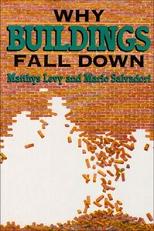
Why Buildings Fall Down
Matthys Levy and Mario Salvadori
334 pages including index
published in 1992
It’s been a real pleasure to read this book. I read a lot of non-fiction, as you may have seen here over the years, but it’s rare that I come across a book that explains a difficult subject as lucidly and understandable as this one. Why Buildings Fall Down, as is obvious from the title, attempts to explain the science behind catastrophical structural collapses by examining various famous and not so famous disasters and tries to find common causes for them. The principle author, Mario Salvadori was a structural engineer with decades of experience in building things that don’t fall down and he and Matthys Levy are very good in translating this experience for the interested layperson like myself.
A great deal of the credit for the clarity of this book however lies also with the illustrator, Kevin Woest. Wherever the technical descriptions in the text get a bit too complicated for me, there was a drawing illustrating it perfectly. Such drawings have an advantage over using photographs, as with photos there’s always too much unimportant detail and often a muddiness in black and white. Woest’s drawings strip away everything that’s not necessary to illustrate a given concept, his art functioning as a plate of clear glass between the reader and the concept. It takes real skill to do this and do this properly.
Why Buildings Fall Down is relentlessly practical in its explenations and therefore doesn’t start with a great wad of theory, but rather dives straight in, instead using historical and more modern case studies to explain enginering concepts. So the importance of good foundations is explained by showing that the lack of them is what caused the pyramid of Meidum to collapse, the fact that the Empire State Building didn’t collapse after a B-25 hit it in 1945 to explain why redundancy in structural supports matters, and so on.
With these fundamentals in hand, the book then goes on to examine other causes of collapse, like e.g. earthquakes and how these can be resisted or how bad design decisions can worsen their impact. With each case study it becomes more clear that however exotic the circumstances underwhich a building collapsed were, the root causes are always the same: an inability to resist pushing or pulling forces on it. Sometimes collapse comes through a peak force too strong for the design, sometimes it’s a prolonged exposure to forces that ultimately causes the collapse, sometimes it’s unexpected peak loads or smaller loads over longer periods that causes these pushing or pulling stresses. But in the end it always comes down to these forces. It’s Salvadori and Levy’s greatest achievement to show how seemingly different causes of building collapse in the end always come down to this.